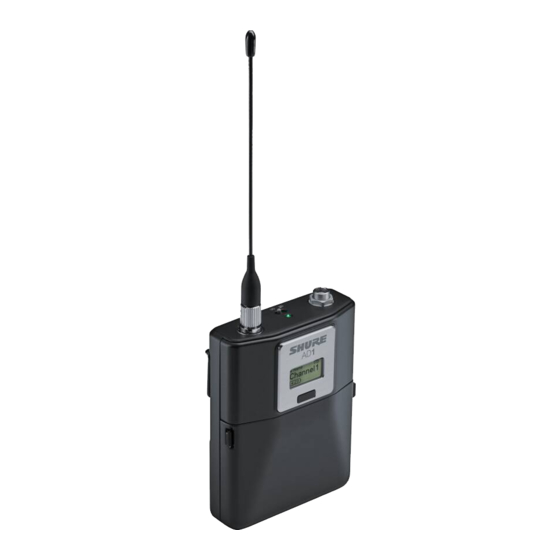
Shure Legendary Performance AD1 User Manual
Hide thumbs
Also See for Legendary Performance AD1:
- Manual (25 pages) ,
- User manual (24 pages) ,
- Manual (24 pages)
Summary of Contents for Shure Legendary Performance AD1
- Page 1 AXIENT DIGITAL AD1 TRANSMITTER USER GUIDE © 2016 Shure Incorporated 27A (Rev. 1) Printed in China...
-
Page 2: Important Product Information
Licensing: A ministerial license to operate this equipment may be required in certain areas. Consult your national authority for possible requirements. Changes or modifications not expressly approved by Shure Incorporated could void your authority to operate the equipment. Licensing of Shure wireless microphone equipment is the user’s responsibility, and licensability depends on the user’s classification and application, and on the selected frequency. -
Page 3: Included Components
• IR Sync function automatically tunes transmitter to the receiver frequency • Shure lithium-ion rechargeable battery delivers up to 8 hours of runtime from a single charge • Advanced control menu to adjust frequency and audio settings from the transmitter •... -
Page 4: Wearing The Bodypack Transmitter
④ Control Buttons Use to navigate through parameter menus and change values. ⑤ Battery Compartment Requires Shure SB900 rechargeable battery or 2 AA batteries. ⑥ AA Battery Adapter Remove to accommodate a Shure SB900 battery ⑦ SMA Connector Connection point for RF antenna. -
Page 5: Setting The Aa Battery Type
② Installing Batteries - AA Batteries: Place batteries (note polarity markings) and AA Adaptor as shown - Shure SB900 Battery: Place battery as shown (note polarity markings), remove AA Adaptor from bodypack transmitter, stow AA Adaptor in door for handheld transmitter Note: If using AA batteries, set the battery type using the transmitter menu. -
Page 6: Checking Battery Info
Shure SB900 Rechargeable Battery Shure SB900 lithium-ion batteries offer a rechargeable option for powering the transmitters. Batteries quickly charge to 50% capacity in one hour and reach full charge within three hours. Single chargers and multiple bay chargers are available to recharge the Shure batteries. -
Page 7: Main Menu Parameters
Wireless - Pos: Positive pressure on microphone diaphragm produces posi- RF Power Workbench or Shure ChannelsPlus. tive voltage on pin 2 (with respect to pin 3 of XLR output) and the Higher power settings can extend tip of the TRS output. - Page 8 RF Mute Power-on RF Mute RF Mute prevents transmission of the audio by suppressing the RF sig- Power-on RF Mute places the transmitter in RF Mute mode immediately nal, while allowing the transmitter to remain powered-on. The message when turned on. RF Mute is shown on the home screen.
-
Page 9: Updating Firmware
To take advantage of design improvements, new versions of the firmware can be uploaded and installed using the Firmware Update Manager tool available in Shure's Wireless Workbench 6 (WWB6) software. Software is available for download from http://www. -
Page 10: Frequency Bands And Transmitter Rf Power
Frequency Bands and Transmitter RF Power Frequency Range Band RF Power (mW) (MHz) 470 to 530 10/100 470 to 530 10/50 470 to 510 10/50 479 to 530 10/20 470 to 530 2/10 518 to 578 10/100 518 to 578 10/50 518 to 565 10/20... -
Page 11: Input Connector Diagrams
Input Connector Diagrams TA4M LEMO SHIELD 5 V DC 100 µF 1µF Ground Audio Input 12 dB Bias Voltage 440 pF Audio Input Ground... - Page 12 Shure Incorporated could void your authority to operate the equipment. Licensing of Shure wireless microphone equipment is the user’s responsibility, and licensability depends on the user’s classification and application, and on the selected frequency. Shure strongly urges the user to contact the appropriate telecommunications authority concerning proper licensing, and before choosing and ordering frequencies.
















Need help?
Do you have a question about the Legendary Performance AD1 and is the answer not in the manual?
Questions and answers